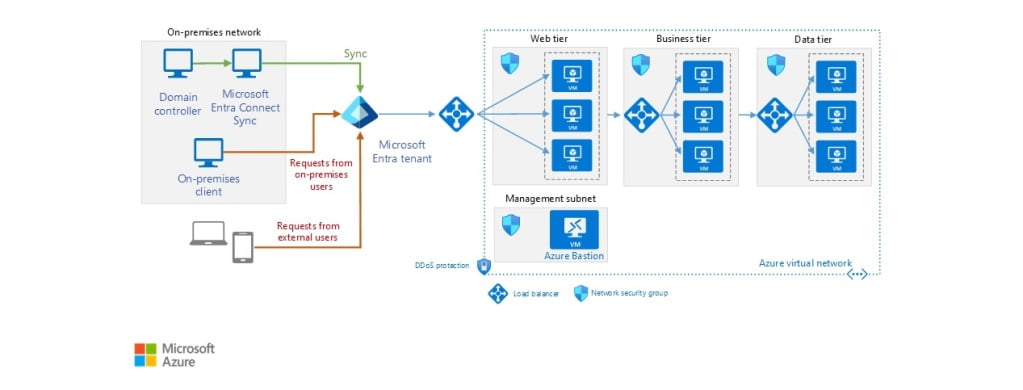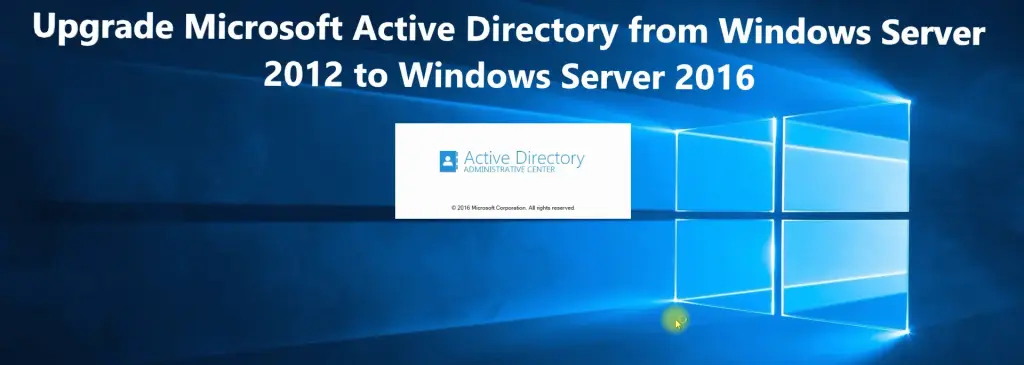Can Azure AD Replace On-Premise AD?
In today’s rapidly evolving technological landscape, the question of whether Azure Active Directory (Azure AD) can fully replace an on-premises Active Directory (AD) is more relevant than ever. Many organizations are shifting toward the cloud, and Microsoft’s Azure AD or Entra ID, a cloud-based identity and access management service, plays a central role in this transition. While Azure AD cannot be a direct replacement for on-premise AD in all cases, it offers significant benefits. This blog will explore the pros and cons of using Azure AD in place of on-premise AD, the best-case scenarios for migration, and a detailed migration path.
What are Azure AD and On-Premise AD?
Before delving into whether Azure AD can replace on-premise AD, it’s crucial to understand what each service offers:
- On-Premise Active Directory (AD): A traditional, domain-based directory service provided by Windows Server. It manages domain networks and provides authentication, group policies, and services like LDAP, Kerberos, and DNS for internal infrastructure.
- Azure Active Directory (Azure AD/ Entra ID): A cloud-based identity and access management service offered by Microsoft Azure. While it focuses on providing identity services for SaaS applications, Microsoft 365, and external resources, it also supports hybrid identity scenarios. You can refer to Microsoft’s official documentation
Can Azure AD Replace On-Premise AD?
Azure AD can partially replace on-premises AD, but it depends on the organization’s requirements. Azure AD is designed for cloud-based infrastructure, focusing on identity and access management for external resources, while on-premise AD handles local resources, authentication, and policies in traditional environments.
Why Azure AD is Not a Direct Replacement
Azure AD is not a direct replacement for on-premises AD because:
- Lack of Group Policy Management (GPO): Group Policies are widely used in traditional environments to manage configurations across devices. Azure AD lacks this capability, though Microsoft Endpoint Manager (Intune) can replicate some features.
- No Support for Kerberos or NTLM: These protocols are the backbone of on-premises AD authentication. Azure AD uses OAuth 2.0, OpenID Connect, and SAML instead.
- No LDAP or SYSVOL Support: Unlike on-premises AD, which uses LDAP for directory services, Azure AD does not support these. It’s primarily an identity provider for cloud services.
- Device Management: Azure AD doesn’t manage devices in the same way that on-premises AD does. However, by combining Azure AD with Intune, device management can be achieved for cloud-joined devices.
Benefits of Replacing On-Premise AD with Azure AD
Even though Azure AD is not a one-to-one replacement for on-premises AD, it can offer significant benefits if used in the right context. Here’s a look at the advantages of moving from on-premise AD to Azure AD:
1. Cost Savings
With Azure AD, organizations no longer need to maintain physical infrastructure, such as servers and storage, which significantly reduces costs related to hardware, power, cooling, and data center maintenance.
2. Cloud-First Approach
As businesses move towards a cloud-first strategy, Azure AD is designed for modern cloud environments. It integrates seamlessly with Microsoft 365, Azure, and other SaaS applications, providing a cloud-based identity solution for users and external resources.
3. Improved Security
Azure AD offers several advanced security features, including:
- Conditional Access: Helps protect resources by ensuring only compliant devices can access corporate resources.
- Multi-Factor Authentication (MFA): Enforces additional security layers.
- Identity Protection: Provides risk-based conditional access and automated responses to suspicious activities.
On-premise AD lacks some of these advanced features unless combined with additional solutions.
4. Simplified Access Management
Azure AD’s Single Sign-On (SSO) allows users to access multiple cloud applications with one set of credentials. This helps simplify user access management, which is a key pain point in traditional environments.
5. Scalability
On-premise AD infrastructure requires physical resources to scale. Azure AD is fully scalable, allowing organizations to expand or reduce resources based on real-time needs, making it ideal for dynamic businesses.
6. Easy Integration with SaaS Applications
Azure AD integrates seamlessly with a wide variety of SaaS applications, like Salesforce, ServiceNow, and Google Workspace, making it a flexible identity provider for organizations using multiple platforms.
Pros and Cons of Replacing On-Premise AD with Azure AD / Entra ID
Pros
- No On-Prem Hardware: Eliminates the need for costly on-premise infrastructure and reduces IT overhead.
- Advanced Security Features: Azure AD provides security enhancements like Conditional Access, MFA, and Azure AD Identity Protection.
- Integration with Cloud Services: Works seamlessly with Microsoft 365, Azure, and other cloud services, offering a unified identity solution.
- Global Accessibility: Users can authenticate from anywhere, providing better flexibility for remote and hybrid work environments.
- Automatic Updates: No need to maintain or update physical infrastructure; Microsoft handles everything.
Cons
- Limited Device and Group Management: Azure AD lacks features like Group Policies (GPOs) and comprehensive device management compared to on-prem AD. However, Microsoft Endpoint Manager and Intune can fill this gap.
- Complex Hybrid Environment: For many organizations, going fully cloud-based might not be feasible, leading to complex hybrid configurations that require Azure AD Connect.
- No Support for Legacy Protocols: Azure AD does not support legacy protocols like Kerberos and LDAP, which are still heavily used in traditional environments.
- Licensing Costs: Azure AD premium features, like conditional access, MFA, and identity protection, require additional licensing, increasing costs.
- Dependency on Internet Connectivity: Azure AD relies heavily on Internet connectivity for authentication and access, which could be a downside for organizations with unreliable Internet access.
Best-Case Scenarios for Using Azure AD
While Azure AD may not completely replace on-premises AD, it shines in several use cases:
- Cloud-Only or Cloud-First Organizations: Businesses that are fully cloud-based or primarily use SaaS applications benefit significantly from Azure AD’s cloud-native identity management.
- Remote and Hybrid Workforces: Azure AD is ideal for organizations with a remote or hybrid workforce, as it allows for secure, global authentication and access without relying on on-premises infrastructure.
- Organizations Using Microsoft 365: Azure AD is tightly integrated with Microsoft 365, so organizations already using these services can streamline their identity management by migrating to Azure AD.
- SMBs Without Legacy Dependencies: Small-to-medium-sized businesses that do not rely on legacy applications or on-premise resources can move to Azure AD without much disruption.
Migration Path: Moving from On-Premise AD to Azure AD

If your organization decides to replace on-premise AD with Azure AD, a well-planned migration path is essential for a successful transition.
1. Assess Your Environment
Start by assessing your existing infrastructure and identifying what services are tied to your on-prem AD. This includes applications, group policies, file shares, network services, and more.
2. Implement Hybrid Identity with Azure AD Connect
For most organizations, moving directly from on-prem AD to Azure AD is not practical. Instead, a hybrid identity solution using Azure AD Connect is often necessary. This service synchronizes your on-premise AD with Azure AD, allowing for seamless single sign-on (SSO) and authentication across both environments.
Steps for setting up Azure AD Connect:
- Download and install Azure AD Connect on your on-prem server.
- Configure synchronization options (password sync, pass-through authentication, or federation).
- Sync your users and groups with Azure AD.
3. Device and Application Management
If your organization relies heavily on Group Policies (GPOs), consider using Intune and Microsoft Endpoint Manager to replicate these configurations in Azure AD. You’ll also need to evaluate whether your applications are compatible with Azure AD or if they need Azure AD Application Proxy.
4. Migrate Identity Services
If you have on-premise applications that depend on LDAP or Kerberos, evaluate alternatives, such as Azure AD Application Proxy or Azure AD Domain Services, to bridge the gap.
5. Test and Monitor
Before fully cutting over to Azure AD, implement in phases and perform extensive testing. Monitor user access, authentication logs, and ensure that there are no disruptions to business-critical processes.
6. Decommission On-Premise AD
Once you are confident that Azure AD is handling all identity services effectively, you can decommission your on-prem AD infrastructure, eliminating the need for physical servers and hardware maintenance.
Also Read: 5 Valid Reasons for Moving to Azure AD Domain Services
Conclusion
While Azure AD/Entra ID is not a direct replacement for on-premise AD, it can serve as a powerful solution for organizations transitioning to the cloud or looking for modern identity management. The decision to migrate should depend on your specific requirements, infrastructure, and long-term IT strategy. For organizations already using cloud services or with a remote workforce, Azure AD/Entra ID can provide robust security, scalability, and cost savings, making it a valuable part of your cloud strategy.
For businesses still relying heavily on on-premise infrastructure, adopting a hybrid identity model with Azure AD Connect is a practical middle ground, allowing you to leverage the cloud while maintaining necessary on-prem resources.
If you’re considering a full migration, start with a detailed assessment of your environment, plan carefully, and make use of tools like Azure AD Connect, Intune, and Endpoint Manager to ensure a smooth transition.
- Why should you automate Active Directory cleanup? - 17 June 2025
- Troubleshooting: Unable to Add Instance Failover Group to Azure SQL Managed Instance - 4 March 2025
- 10 Azure Virtual Desktop (AVD) Cost-Optimization Strategies for 2025 💡💰 - 22 February 2025



